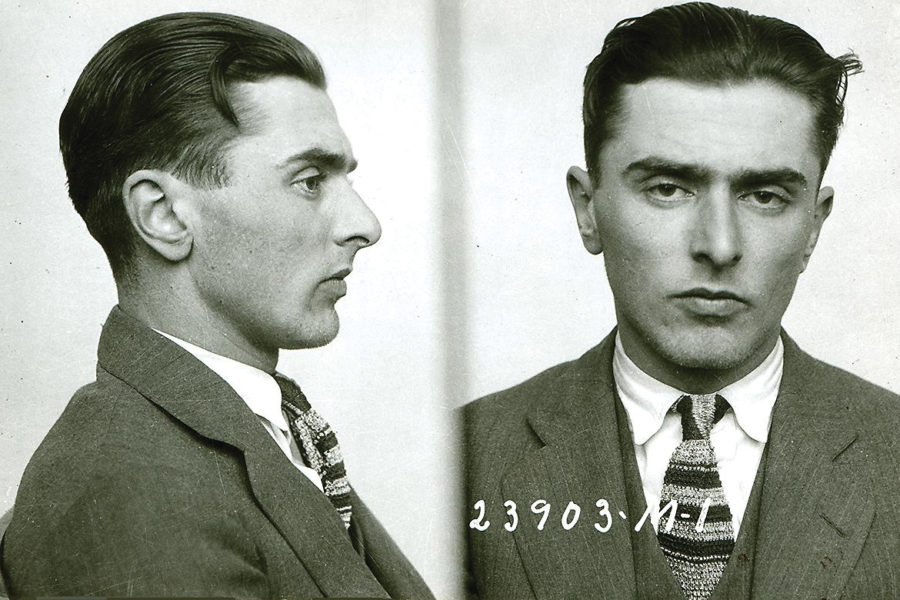
Several years ago, I wrote a book with Glenn Macnow, the radio sports commentator, about mob movies. It was called the Ultimate Book of Gangster Movies and it opened with these lines: “Walk into any bar where guys hang out and it’s a good bet they are discussing one of three topics—sports, women or movies. It’s also a good bet that most of those guys can speak with knowledge and intelligence about two of those topics. This is a book about one of them—movies. More specifically gangster movies.”The book went on to list what we considered the 100 best mob movies of all time and included an essay on each film along with lots of trivia and other stories related to the real life and reel life of the gangster.
Two new books, one published late last year and one that was scheduled to be released last month, have refocused attention on the mob and the movies. The first, and better of the two, is HANDSOME JOHNNY, The Life and Death of Johnny Rosselli: Gentleman Gangster, Hollywood Producer, CIA Assassin. Written by Lee Server, the book is a fascinating account of the life and times of one of the more significant—yet least publicized—gangsters in American history.
Born Filippo Sacco in a small town near Naples, Rosselli came to America as a child with his immigrant parents in the early 1900s, settling in Boston. How and why he changed his name, how he became a major player in the underworld with strong ties to the Chicago Outfit and how he positioned himself as the point man for the mob in the early days of Hollywood are all part of the Johnny Rosselli story. And that’s only the first act. There’s also an account of his days as the mob’s rep in Las Vegas and his dealings with the eccentric billionaire Howard Hughes, his involvement with the CIA, the plot to kill Cuban dictator Fidel Castro and the assassination of President John F. Kennedy.
It’s American history from the underworld’s perspective and Server has done a great job researching and writing a story that revolves around the dapper, charismatic and soft-spoken wiseguy who could have stepped off one of the movie sets in which he had a hidden interest.
Equally entertaining is HOLLYWOOD GODFATHER, My Life in the Movies and the Mob written by Gianni Russo with Patrick Picciarelli. Russo played Don Corleone’s son-in-law Carlo Rizzi in the classic mob movie and frankly writes that he has used that connection to build a series of careers in both the entertainment industry and the underworld.
His memoir is both incredible and fantastic—incredible as in hard-to-believe and fantastic as in are you making this stuff up? Russo emerges as an underworld Forrest Gump, a character who happened to be on hand for virtually every major mob-linked historic event in the 20th century.
Now in his seventies, Russo’s story begins in New York and includes a harrowing account of how he spent nearly five years as a youngster confined to a polio ward in a city hospital. Describing himself as a hustler who was always looking for a way to make money, he said he was taken under the wing of legendary New York mob leader Frank Costello as a teenager. His story takes off from there.
WOMEN?
Russo said he was running errands for Costello and working in a hair salon when he met a young starlet through his mob ties. They ended up spending lots of time in bed.
Her name? Marilyn Monroe.
After she became a star, she moved in some of the same Hollywood and political circles that he did, and they reconnected, at least socially. Her death, ruled a drug overdose, was, in fact, a politically-ordered murder, he contends.
GANGLAND?
Russo recounts how the mob had to okay the filming of The Godfather, and how he was able, through his neighborhood connections and ties to Costello, to get the movie greenlighted by the wiseguys, including mob boss Joe Colombo whose Italian-American Civil Rights League was threatening to scuttle the film.
He also writes that he was warned off attending a 1972 civil rights league rally in New York during the filming of The Godfather, a rally at which Colombo was shot. Russo said his failure to take a seat on the stage in Columbus Circle that day led some in Colombo’s organization to suspect he had played a role in the hit.
DRUGS?
The book opens with Russo shooting a narco-trafficker who had brutally slashed a woman in the Las Vegas restaurant that Russo owned. The drug dealer died. Russo was exonerated criminally, but eventually had to plead his case to a higher court, the drug dealer’s boss.
The drug boss? Pablo Escobar. Who else?
He met with the cocaine kingpin in Colombia. The meeting was arranged by none other than John Gotti, a mob boss whom Russo said he neither liked nor trusted. Russo believes he was set up to be killed by Gotti, but that once Escobar realized Russo had played a key role in his favorite movie, all was forgiven. But only after Russo agreed to act out a scene from the movie with Escobar in the role of Michael Corleone.
HIGH FINANCE?
Russo details how he was a courier for the mob, taking money skimmed from Las Vegas casinos to Rome where the mob, through its connections to the Vatican Bank, was able to set up a money laundering operation. He also claims the mob knocked off Pope John Paul I because the pontiff planned to end the highly lucrative, multi-million dollar scheme.
His experiences moving money to the Vatican, he writes, came in handy later when he was asked to expedite the removal of millions of dollars from Iran. The money belonged to the Shah who was about to be deposed by the mullahs.
POLITICAL INTRIGUE?
Russo writes that he was serving as a messenger for Costello in 1963 when he was sent to meet with New Orleans mob boss Carlos Marcello. During the meeting, Russo said he noticed another man that day who had also met with Marcello that day.
The man? Lee Harvey Oswald.
Costello, Russo writes, sent him to live in Europe after the assassination of John F. Kennedy. Russo believes this was Costello’s way of keeping him out of harm’s way as the feds and the mob cleaned up loose ends following the JFK hit.
Johnny Rosselli, who also was believed to have intimate knowledge of the mob’s involvement in the Kennedy assassination, wasn’t as lucky. In 1976 his decomposing body was found in a 55-gallon steel drum floating in the bay near Miami. Some said he was killed by the mob because he had testified before a U.S. Senate committee looking into CIA plots to kill Castro in which he had played a role. Others said he was dispatched because of what he knew about the mob’s involvement in the murder of JFK.
The Kennedy assassination and CIA plans to bump off Castro are two of the historical moments in which the Rosselli and Russo stories overlap. Another is their heavy involvement in the mob’s business in Las Vegas.
Rosselli was a made guy who traced his mob origins back to Al Capone. Russo said he never wanted the button, but traced his mob ties back to Costello, a mob figure just as powerful and legendary as Scarface.
Rosselli was a Mafia diplomat who used the power of the organization to negotiate deals and take care of business. Russo was a hustler who used his mob ties to wheel and deal in both the underworld and in Hollywood.
Both men benefitted financially from their links to the organization. Both had more than their share of beautiful women along the way. And both had an up close and personal view of the role organized crime played in some pivotal moments in American history.
Rosselli’s story is presented with detailed documentation. It is a highly researched account by a credible writer. Russo’s personal memoir is a fascinating but at times hard to believe saga. It’s like Forrest Gump’s box of chocolates—you’re never quite sure about the content.
Both would make great films that would certainly be included in an expanded version of Ultimate Book of Gangster Movies.
For those interested, the top five films in that book were:
1. The Godfather
2. The Godfather, Part II
3. Goodfellas
4. On the Waterfront
5. Pulp Fiction
The only serious debate over rankings that I remember Glen Macnow and I had involved the Al Pacino remake of Scarface. I think Glen wanted it in the top ten. I didn’t even want it in the top twenty. We settled on ranking it at 16. The original Scarface starring Paul Muni came in at 11. The rankings were subjective, of course, and were based on the cinematic quality of the film, its social and historical impact and our personal likes and dislikes.
Overall, I think the rankings, now eight years after the book was published, hold up pretty well. Separate and apart were my favorite mob movies, which may shed some light on where I was coming from as an evaluator. My favorites are Leon (The Professional), The Pope of Greenwich Village and The Friends of Eddie Coyle. They were ranked 13, 21 and 38. Just something to talk about the next time you’re sitting in a bar with a group of friends. This would be after you’ve grown tired of talking about sports and you’ve realized that when it comes to women, we don’t have a clue.

